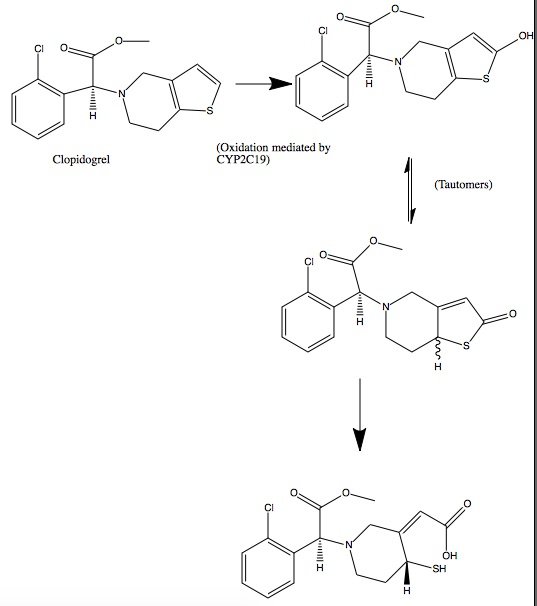Sandbox Reserved 430
From Proteopedia
(Difference between revisions)
| Line 36: | Line 36: | ||
==Additional Features== | ==Additional Features== | ||
| - | Acute coronary syndrome, a condition in which there is sudden blockage of blood flow to the heart, is majorly caused by a disease known as atherothrombosis. This disease is characterized by | + | Acute coronary syndrome, a condition in which there is sudden blockage of blood flow to the heart, is majorly caused by a disease known as atherothrombosis. This disease is characterized by clogged arteries due to thrombosis: formation of a clot within a blood vessel. The P2Y12 protein is an important platelet receptor inhibitor that can be combined with aspirin in the management of ACS. It regulates certain functions through purinergic signaling, which is a form of extracellular signaling mediated by purine nucleotides and nucleosides like ADP and ATP. |
| - | The P2Y12 receptor is mainly found on the surface of blood platelets, and functions as a regulator in platelet activation and | + | The P2Y12 receptor is mainly found on the surface of blood platelets, and functions as a regulator in platelet activation and blood clotting. The P2Y12 receptor is a G-protein coupled receptor, <scene name='48/483887/First/1'>a seven-transmembrane domain protein</scene> linked to the cAMP-signaling pathway. It mediates platelet activation by decreasing intracellular cAMP levels through inhibition of an AC-mediated signaling pathway. Acting as a chemoreceptor, P2Y12 utilizes ADP as an agonist, which initiates ADP-induced platelet aggregation. Clopidogrel in covalent binding complex with P2Y12 acts as an anti platelet agent, specifically as an ADP receptor inhibitor to decrease platelet aggregation and inhibit thrombus formation.[2] |
| - | Clopidogrel is a pro-drug and thienopyridine-type inhibitor of the P2Y12 receptor, which requires Cytochrome P450 to hepatically transform it to exert its anti platelet effect. <scene name='48/483887/P450/3'>Cytochrome P450</scene> is a membrane protein, characteristic of alternating <font color='gray'>hydrophobic</font> and <font color='pink'>polar</font> groups. The central heme group is stabilized by several side chains. The <font color='orange'>Fe2+</font> atom that makes up the heart of the heme group is surrounded by a <font color='blue'>highly hydrophobic porphyrin ring</font> . The role of the heme group in biological systems is to facilitate oxygen transport as well as aid in electron transfer as part of the electron transport chain. The heme group of the hemeprotein Cytochrome P450 acts as a catalyst for the metabolism of clopidogrel. Shown below is the activation of Clopidogrel in vivo. CYP2C19 is an enzymatic member of the cytochrome P450 mixed-function oxidase system. The final step is a hydrolysis to yield the active metabolite. | + | Clopidogrel is a pro-drug and thienopyridine-type inhibitor of the P2Y12 receptor, which requires Cytochrome P450 to hepatically transform it to exert its anti platelet effect. <scene name='48/483887/P450/3'>Cytochrome P450</scene> is a membrane protein, characteristic of alternating <font color='gray'>hydrophobic</font> and <font color='pink'>polar</font> groups. The central heme group is stabilized by several side chains. The <font color='orange'>Fe2+</font> atom that makes up the heart of the heme group is surrounded by a <font color='blue'>highly hydrophobic porphyrin ring</font> . The role of the heme group in biological systems is to facilitate oxygen transport as well as aid in electron transfer as part of the electron transport chain. The heme group of the hemeprotein Cytochrome P450 acts as a catalyst for the metabolism of clopidogrel. Shown below is the activation of Clopidogrel in vivo. CYP2C19 is an enzymatic member of the cytochrome P450 mixed-function oxidase system.[3] The final step is a hydrolysis to yield the active metabolite. Work with the active metabolite of the related drug prasugrel suggests the R-configuration of the C4 group is critical for P2Y12 and platelet-inhibitory activity.[1] (Shown below in R configuration) |
[[Image:Clop converted.jpg]] | [[Image:Clop converted.jpg]] | ||
| Line 67: | Line 67: | ||
==References== | ==References== | ||
<references/> | <references/> | ||
| + | 1. https://en.wikipedia.org/wiki/Clopidogrel#/media/File:Clopidogrel_activation.svg | ||
| + | 2. http://www.ncbi.nlm.nih.gov/pubmed/15199474 | ||
| + | 3. https://en.wikipedia.org/wiki/CYP2C19 | ||
| + | 4. http://www.rcsb.org/pdb/explore.do?structureId=1HZX | ||
Revision as of 21:57, 10 April 2016
| This Sandbox is Reserved from January 19, 2016, through August 31, 2016 for use for Proteopedia Team Projects by the class Chemistry 423 Biochemistry for Chemists taught by Lynmarie K Thompson at University of Massachusetts Amherst, USA. This reservation includes Sandbox Reserved 425 through Sandbox Reserved 439. |
P2Y12 Receptor in Complex with AZD1283 (4ntj)[1]
by [Cora Ricker, Lauren Timmins, Aidan Finnerty, Adam Murphy, Duy Nguyen]
Student Projects for UMass Chemistry 423 Spring 2016
| |||||||||||

